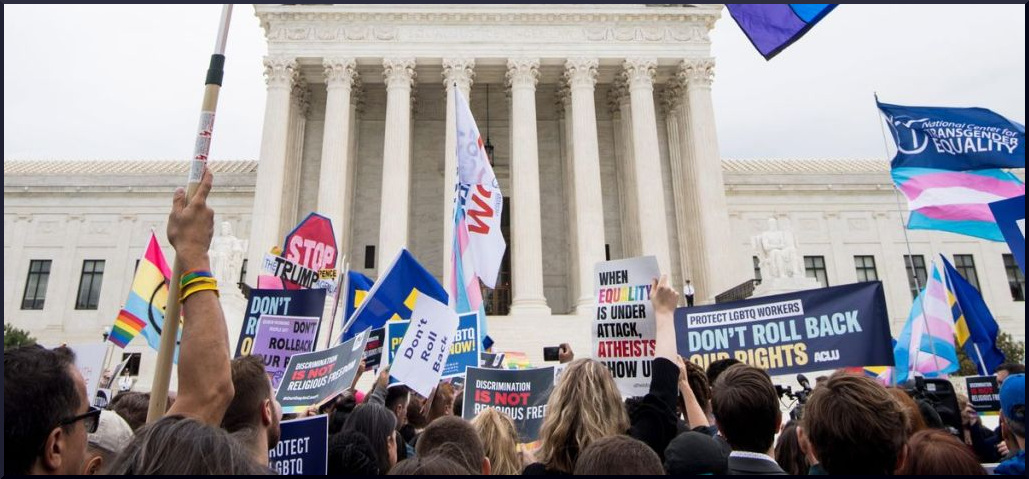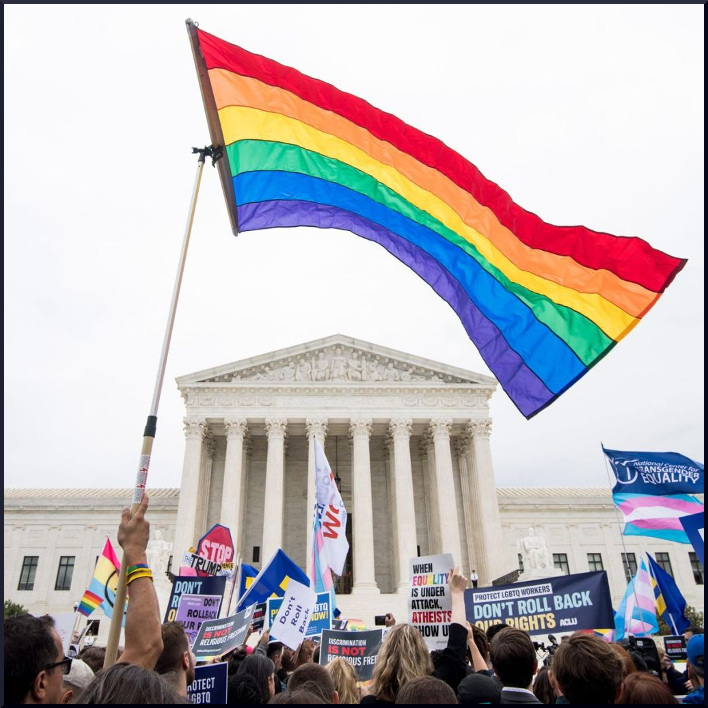By Ann Montegue, published on Socialist Action, June 24, 2020
On June 15, the U.S. Supreme Court by a wide 6-3 margin immediately expanded job protections to LGBTQ workers in 23 states where none had existed. Over the past decades, some states had included bans on employment discrimination. Many union contracts included protections. But in those 23 states few workers have unions, and workers are routinely fired with no grounds for legal redress when based solely on their sexual orientation or gender identity.
The strategy of the case was unique and not complex. It revolved around the word “sex” in a law that had long been accepted as a bulwark against discrimination in the United States. The Supreme Court decision reflected that simplicity in its brevity and clarity.
The question of whether the word “sex” includes sexual orientation and gender identity was clarified in the decision written by President Trump’s first Supreme Court nominee, Justice Neil Gorsuch:
“It is impossible to discriminate against a person for being homosexual or transgender without discriminating against that individual based on sex. An employer who fired an individual for being homosexual or transgender fires that person for traits or actions it would not have questioned in members of a different sex. Sex plays a necessary and undisguisable role in the decision, exactly what Title VII [of the Civil Rights Act] forbids.”
The court also specifically upheld rulings of lower courts that said sexual orientation discrimination was a form of sex discrimination.
This decision is broader and ultimately more far reaching than two previous decisions. In 2003 Lawrence v. Texas established the constitutional right to private sexual expression. The 2015 decision in Obergefell v. Hodges established the constitutional right to marry. The right to have sex and the right to marry in no way protected workers from discrimination in the workplace.
The Plaintiffs
Gerald Bostock was a social worker for Clayton County Georgia who was fired after he joined a gay softball league. Donald Zarda was a skydiving instructor who was fired by Altitude Express after mentioning being gay. Aimee Stephens was fired by R.G. & G.R. Funeral Home. She presented as male when she was hired. After she informed her employer she planned to “live and work full-time as a woman,” she was fired. Her employer said she violated the dress code and said, “this is not going to work.”
The plaintiffs claimed their employers had violated Title VII of the 1964 Civil Rights Act, which prohibits discrimination based on “race, color, religion, sex or national origin.”
The central dispute was the word “sex.”
The Civil Rights Act was created in the midst of the struggle for Black Liberation and a year after Martin Luther King’s March On Washington for Jobs and Freedom. Chief organizers of the march were A. Phillip Randolph, a union organizer who founded the Brotherhood of Sleeping Car Porters, and openly gay civil rights activist Bayard Rustin.
The question of whether to even add sex as a protected class to the 1964 Civil Rights Bill created controversy from the beginning. Segregationist Rep. Howard Smith, Democrat from Virginia thought that adding “sex” would sound so ridiculous that it would derail the passage of the entire bill. He clearly underestimated the effect of the growing women’s liberation movement.
This Was a Working Class Fight
The fact that job protections often took the back seat to marriage rights reflects the money and power of a few national organizations. They were successful and marriage equality became the law of the land in all fifty states. A popular slogan which ridiculed the situation they created became widespread: “Now we can get married on one day and get fired the next”.
Some lobbying organizations were just currying favor with Democrats and raising money. But from the beginning the struggle for workplace rights had always been front and center for workers.
That long struggle did not start with individuals being fired because they were discovered to be gay. It started because lesbians and gay men were facing mass firings that started in the U.S. State Department. This was an integral part of the Cold War anti-Communist witch hunts. (“The Lavender Scare: The Cold War Persecution of Gays and Lesbians in the Federal Government” by David Kay Johnston)
In 1957 Frank Kameny, an astronomer in the U.S. Army Map Service, was fired for being gay. A few years later, Kameny and Barbara Giddings, founder of the Daughters of Bilitis the first lesbian civil rights organization, joined together to initiate a series of nationwide visible gay protests. One of the most prominent was a 1965 picket in front of the White House.
As the gay liberation movement spread across the country so did the mantra, “come out, come out, wherever you are”. At the same time rank and file stewards, organizers and leaders in unions started coming out and engaging with their co-workers. They bargained contract language to protect gays, lesbians and trans workers in their jobs and fought for equal health benefits. They followed it up with training stewards on the new contract language and going to bat for their co-workers. (“Out In The Union: A Labor History Of Queer America” by Miriam Frank)
Myths About the Supreme Court
Some people were surprised that the majority decision was written by Justice Neil Gorsuch and supported by Chief Justice John Roberts. There is a myth that the justices exist in an isolated cloister apart from society and immune to pressure by social movements. This has never been true. In addition, the Democrats’ incessant cry to the working class that they must vote for the “lesser evil” – because Democrats will appoint justices who are more “progressive” – is also not true. Note that the same week as the decision regarding expansion of job protections there was another decision. Ruth Bader Ginsburg and Stephen Breyer, both appointed by Democrat Bill Clinton, voted with the majority which upheld a permit for a controversial $8 billion gas pipeline that will tunnel below the famous Appalachian Trail.
The 1973 Roe v. Wade decision that women have a fundamental right to decide whether or not to have an abortion without government restriction came from a conservative court. It was a 7-2 decision with all Republican appointed justices voting in the majority and the one Democratic appointee voted “no.”
What is true is the effect a strong independent movement can have on court decisions. Roe v. Wade came at the time when a militant women’s liberation movement was on the rise. Today there is an unprecedented mass movement erupting against police brutality in small towns as well as large cities throughout the nation. These mobilizations are continuing and only getting stronger as the rebellion expands against injustice and in some cases questioning the capitalist system itself. This is a time of fighting back
At the center of the expansion of job protections decision is the 1964 Civil Rights Act. This decision came in the midst of weeks of protests against systemic racism and violence directed at Black men and women. The very people this act was supposed to protect but instead now represents the years of “reform” that has failed.
Housing and Healthcare
There are additional areas of discrimination that this decision does not cover. The lawyers in this case believe that because federal law already prohibits sex discrimination in housing through the Fair Housing Act, that should end housing discrimination in all 50 states based on sexual orientation and gender identity.
Healthcare may be more challenging but also there is a possibility of a broad-based movement in this case. While it is true that President Trump is stripping away protections for trans persons, the attack is also much broader. The Trump Administration reversed the Health and Human Services (HHS) rule which prohibited discrimination in healthcare. This means denial of healthcare or healthcare coverage based on pregnancy, gender identity and sexual orientation is no longer prohibited. New exemptions have been added that allow healthcare providers to invoke religious objections to service provision. Healthcare providers must now comply with the Religious Freedom Restoration Act.
This harms women seeking abortions as well as allowing discrimination on the basis of gender identity and sexual orientation. The victory here belongs to the religious right who are waging a war on women and LGBTQ people against the principle that health care is a human right.
It is time for a united, broad-based movement to demand: No Exceptions! Healthcare Is A Human Right! Free Universal Healthcare For All!
Stand Up, Fight Back!
This is a time of general defiance and a new generation experiencing the power of independent mass movements. Laws and court decisions are only pieces of paper if the struggles don’t continue. Those 23 states who just heard they cannot discriminate will not just change because of a court decision. The capitalist class benefits from divisions in the working class. Now is the time for workers to unite: An Injury To One Is An Injury To All!

